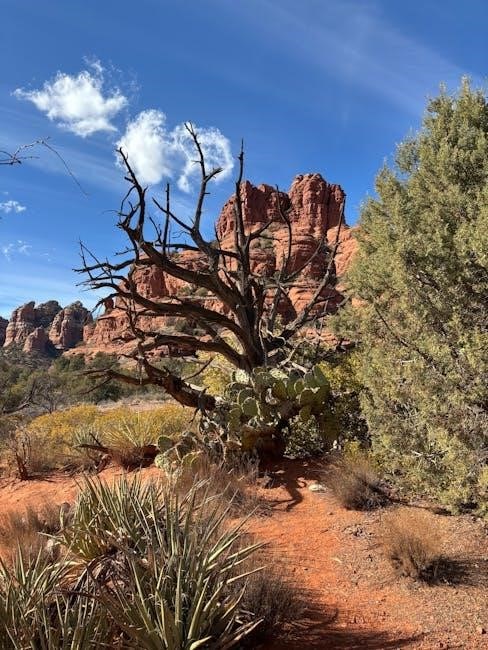Arizona desert landscaping presents unique opportunities and challenges. Selecting appropriate plants is crucial for creating sustainable and visually appealing landscapes. The “Landscape Plants for the Arizona Desert” booklet aids in this process.
The Unique Challenges of Arizona Desert Landscaping
Landscaping in the Arizona desert presents a distinct set of challenges. The arid climate‚ characterized by low humidity‚ intense sunlight‚ and minimal rainfall‚ demands careful consideration when selecting plants. Alkaline soils‚ common in desert environments‚ further restrict plant choices. Water scarcity is a major concern‚ necessitating water-wise landscaping approaches like xeriscaping. Furthermore‚ the extreme temperature fluctuations between day and night‚ as well as seasonal variations‚ require plants that can withstand these harsh conditions.
Successfully navigating these challenges involves understanding the specific needs of desert-adapted plants. Proper soil preparation‚ efficient irrigation techniques‚ and strategic plant placement are essential for creating thriving landscapes. The “Landscape Plants for the Arizona Desert” booklet and resources from the Arizona Native Plant Society provide valuable information to overcome these obstacles. Selecting plants that are naturally suited to the desert environment is key to minimizing water consumption and ensuring long-term sustainability.
The Importance of Selecting Appropriate Plants
Choosing the right plants is paramount for successful Arizona desert landscaping. Appropriate plant selection ensures sustainability‚ conserves water‚ and enhances the aesthetic appeal of the landscape. Desert-adapted plants require less water‚ reducing the strain on local resources and lowering maintenance costs. Selecting native or well-adapted species promotes biodiversity and supports local ecosystems. These plants are naturally resistant to pests and diseases prevalent in the desert environment‚ minimizing the need for chemical interventions.
Furthermore‚ appropriate plant selection creates visually harmonious landscapes that blend seamlessly with the natural surroundings. By considering factors such as plant size‚ shape‚ color‚ and texture‚ you can design aesthetically pleasing outdoor spaces. The “Landscape Plants for the Arizona Desert” guide and resources from organizations like the Arizona Native Plant Society are invaluable tools for making informed plant choices. Careful planning and plant selection are crucial for creating thriving‚ sustainable‚ and beautiful desert landscapes.
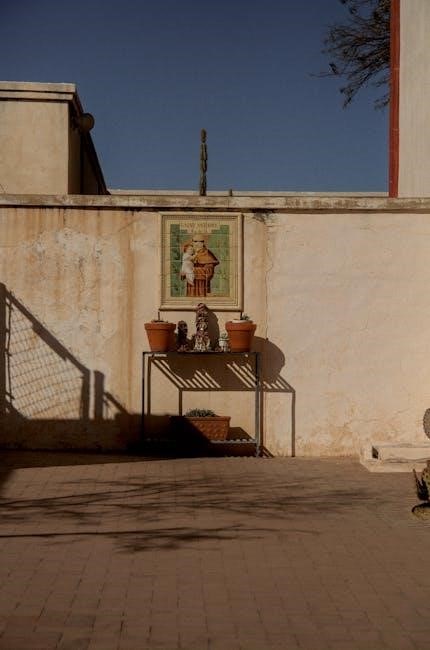
Understanding Arizona Desert Plants
Understanding Arizona desert plants involves differentiating between native and non-native species. It also requires recognizing the unique characteristics that allow these plants to thrive in arid conditions‚ such as water storage.
Native vs. Non-Native Desert Plants
When considering plants for Arizona desert landscapes‚ a key decision involves choosing between native and non-native species. Native plants‚ like those from the Sonoran and Chihuahuan deserts‚ are naturally adapted to the local climate‚ requiring less water and maintenance. They also support local ecosystems by providing food and shelter for native wildlife.
Non-native desert plants‚ on the other hand‚ come from other arid regions worldwide. While some can thrive in Arizona‚ it’s crucial to select species that won’t become invasive or disrupt the native ecosystem. Many outstanding plants from other arid regions offer unique aesthetic qualities. Choosing the right plants and trees for your yard means considering water wise plants that vary in color‚ texture‚ form‚ and function; The Arizona Native Plant Society offers resources to help with plant selection.
Ultimately‚ the best approach often involves a combination of native and well-adapted non-native plants to create a diverse and sustainable landscape.
Characteristics of Desert-Adapted Plants
Desert-adapted plants possess unique characteristics that enable them to thrive in arid environments. One of the most common adaptations is water storage‚ often seen in succulent leaves or stems. These plants store water during infrequent rainfall events‚ allowing them to survive extended periods of drought.
Deep root systems are another crucial adaptation‚ allowing plants to access groundwater sources far below the surface. Other plants have shallow‚ widespread root systems to quickly absorb surface water after rainfall. Many desert plants have small or reduced leaves to minimize water loss through transpiration.
Some also feature waxy or hairy leaf surfaces to reflect sunlight and reduce evaporation. Tolerance of alkaline soils is another important characteristic‚ as desert soils often have high pH levels. Understanding these adaptations is essential for selecting and caring for plants in Arizona desert landscapes. These plants are tolerant of desert-like conditions – low humidity‚ low rainfall‚ and alkaline soils‚ making them ideal for xeriscape gardens.
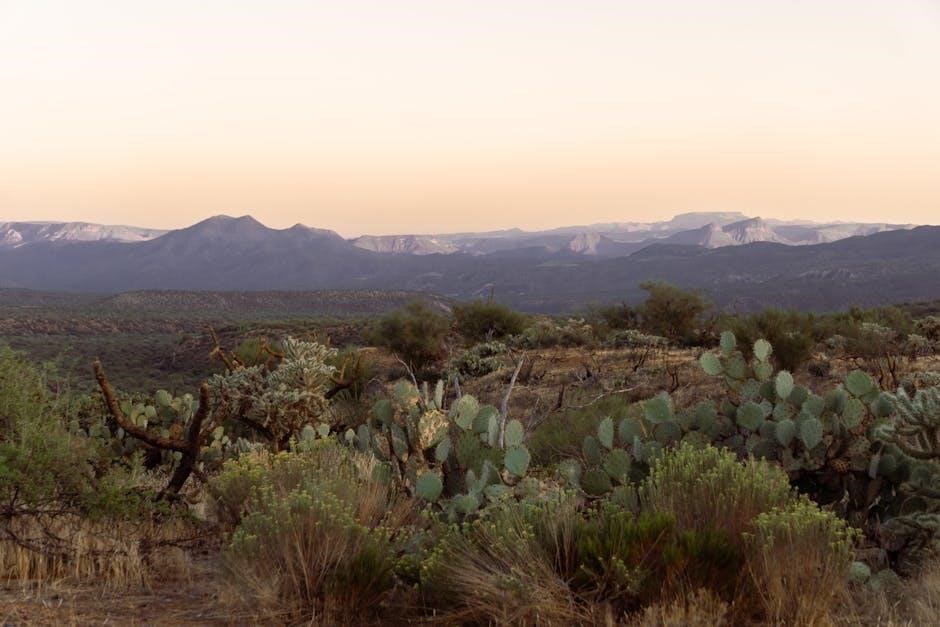
Key Landscape Plants for Arizona
Selecting the right plants is essential for successful Arizona desert landscaping. Consider trees‚ shrubs‚ and groundcovers adapted to arid conditions. The Landscape Plants for the Arizona Desert guide aids in this selection.
Trees for Arizona Desert Landscapes
Selecting the right trees is vital for Arizona desert landscapes‚ offering shade‚ structure‚ and beauty. Consider native and desert-adapted species that thrive in arid conditions. Acacias‚ like the Willow Acacia and Shoestring Acacia‚ are popular choices for their drought tolerance and attractive foliage.
Other suitable options include the Sweet Acacia‚ known for its fragrant‚ golden flowers. When choosing trees‚ assess their mature size‚ water requirements‚ and potential for litter. Some trees may have thorns or produce allergens‚ so consider these factors when making your selection.
Utilize resources like the “Landscape Plants for the Arizona Desert” booklet and local nurseries to explore a variety of options. Consider the aesthetic appeal of the tree‚ including its form‚ texture‚ and flowering season. Proper planning ensures that trees contribute positively to your desert landscape while minimizing water consumption. Remember to check local regulations regarding protected species before planting.
Shrubs for Arizona Desert Landscapes
Shrubs play a crucial role in Arizona desert landscaping‚ adding texture‚ color‚ and structure to the landscape. Selecting the right shrubs is essential for creating a visually appealing and water-wise garden. Consider native and desert-adapted species that thrive in arid conditions and require minimal maintenance.
The Arizona Native Plant Society (ANPS) offers valuable resources for identifying suitable shrubs for your landscape. Justicia spicigera is an excellent option known for its vibrant flowers. When choosing shrubs‚ consider their mature size‚ sun exposure requirements‚ and water needs.
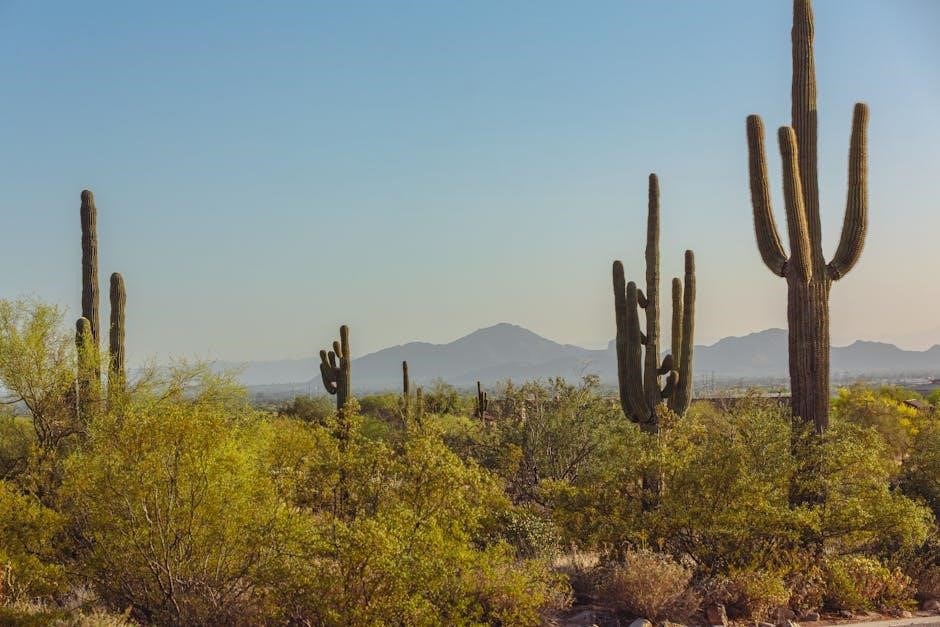
Some shrubs may be evergreen‚ providing year-round interest‚ while others may be deciduous‚ offering seasonal color changes. Ensure that your chosen shrubs complement the overall design of your landscape and contribute to its ecological balance. Pay attention to the plant’s growth habits to avoid future problems. Remember that some plants might be protected by law. Utilize resources like the “Landscape Plants for the Arizona Desert” booklet for plant selection guidance.
Groundcovers for Arizona Desert Landscapes
Groundcovers are essential for Arizona desert landscapes‚ providing soil stabilization‚ weed suppression‚ and aesthetic appeal. Selecting appropriate groundcovers can reduce water consumption and maintenance efforts. Opt for low-growing‚ drought-tolerant varieties that thrive in arid conditions. Native groundcovers are particularly well-suited for Arizona landscapes‚ offering ecological benefits and requiring minimal watering once established.
Consider factors such as sun exposure‚ soil type‚ and desired aesthetic when choosing groundcovers. Some groundcovers‚ like Dyssodia pentachaeta‚ offer colorful blooms‚ while others‚ like Lippia repens‚ provide dense coverage.
Explore the “Landscape Plants for the Arizona Desert” booklet for a comprehensive list of groundcover options suitable for the region. Ensure proper soil preparation and planting techniques to promote healthy groundcover growth. Utilizing groundcovers effectively can create a visually appealing and sustainable desert landscape; Remember to respect any regulations protecting native plants in your area. Consider the plant’s mature size to avoid overcrowding.
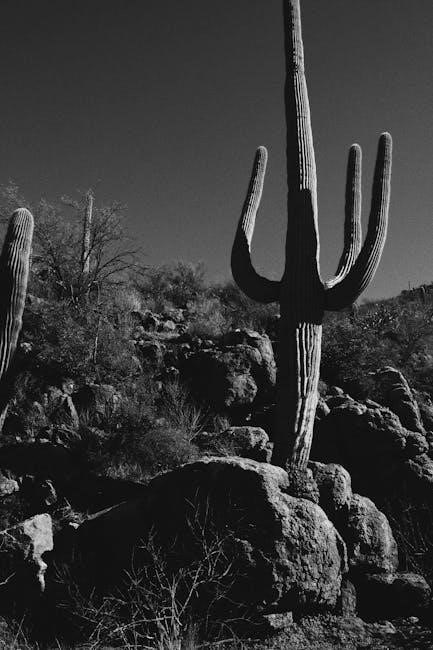
Water-Wise Landscaping (Xeriscaping) in Arizona
Xeriscaping is vital in Arizona‚ reducing water use by 85%. Choosing desert plants and efficient irrigation are key. The “Landscape Plants for the Arizona Desert” booklet helps.
Principles of Xeriscaping
Xeriscaping‚ crucial in arid climates like Arizona’s‚ focuses on water conservation through intelligent landscape design. The first principle involves planning and design‚ carefully assessing the site’s conditions‚ including sun exposure and soil type. Efficient irrigation is paramount‚ employing methods like drip irrigation to minimize water waste. Soil improvement is also critical‚ enhancing water retention and drainage to support plant health. Selecting appropriate plants is fundamental‚ favoring native and desert-adapted species that require minimal watering. Mulching helps retain soil moisture and suppress weeds‚ further reducing water needs. Turf areas should be limited‚ as grass demands significant water resources. Finally‚ regular maintenance is essential‚ including pruning and weed control‚ to ensure the landscape remains healthy and water-efficient. By adhering to these principles‚ homeowners can create beautiful‚ sustainable landscapes that thrive in the Arizona desert while minimizing their environmental impact. Utilizing resources like the “Landscape Plants for the Arizona Desert” PDF can greatly assist in plant selection and landscape planning‚ promoting successful xeriscaping practices.
Reducing Water Consumption in Desert Landscapes
Minimizing water usage in Arizona’s desert landscapes is essential for sustainability. Employing xeriscaping principles is a key strategy‚ starting with careful planning and plant selection. Prioritize native and desert-adapted plants‚ which require significantly less water than non-native species. Efficient irrigation systems‚ such as drip irrigation and soaker hoses‚ deliver water directly to plant roots‚ reducing evaporation and runoff. Group plants with similar water needs together to avoid overwatering some areas while underwatering others. Mulching around plants helps retain soil moisture and suppress weeds‚ further reducing the need for irrigation. Limit turf areas‚ as grass is a water-intensive ground cover; consider replacing lawns with drought-tolerant alternatives like gravel or decomposed granite. Regularly monitor and adjust irrigation schedules based on weather conditions and plant needs. Collect rainwater for irrigation to supplement municipal water sources. Utilize resources like the “Landscape Plants for the Arizona Desert” PDF to guide plant choices and water-wise landscaping practices. Proper soil preparation‚ including amending with organic matter‚ improves water retention and drainage. By implementing these strategies‚ homeowners can create beautiful and sustainable desert landscapes while significantly reducing their water consumption.
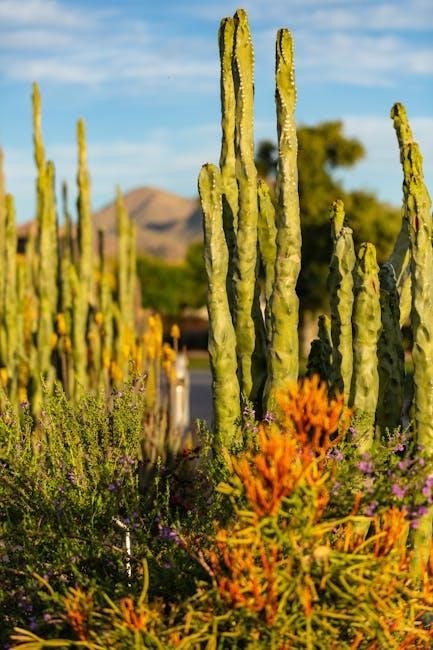
Resources for Selecting Arizona Landscape Plants
Selecting the right plants is key to successful desert landscaping. Resources like the “Landscape Plants for the Arizona Desert” booklet and the Arizona Native Plant Society are invaluable.
The “Landscape Plants for the Arizona Desert” Booklet
The “Landscape Plants for the Arizona Desert” booklet is an invaluable resource for homeowners and landscaping professionals in Arizona. It was designed to take the guesswork out of selecting suitable plants for the arid climate. This comprehensive guide provides detailed information on a wide variety of trees‚ shrubs‚ groundcovers‚ and flowers that thrive in the Arizona desert.
The booklet includes photos and information charts‚ making it easy to identify plants and understand their specific needs. It covers aspects such as water requirements‚ sun exposure‚ soil preferences‚ and mature size. This allows users to make informed decisions and create landscapes that are both beautiful and sustainable. The “Landscape Plants for the Arizona Desert” booklet is a must-have for anyone looking to create a thriving desert landscape.
It helps guide plant selection‚ ensuring successful growth and minimizing water consumption. The booklet is available in PDF format and printed copies.
Arizona Native Plant Society Resources
The Arizona Native Plant Society (ANPS) is a vital resource for individuals seeking information on native plants and their role in sustainable landscaping. ANPS offers numerous resources‚ including publications‚ workshops‚ and field trips‚ to educate the public about the benefits of using native plants in Arizona landscapes.
Their publications‚ such as the “Desert Plants for Urban Landscapes” series‚ provide detailed descriptions and cultural information on a wide range of native shrubs and other plants. These resources highlight the importance of selecting plants that are well-adapted to the desert climate and require minimal water and maintenance. ANPS also advocates for the protection of native plant communities and promotes responsible harvesting practices.
By utilizing ANPS resources‚ homeowners and landscape professionals can create beautiful‚ water-wise landscapes that support local ecosystems and conserve precious water resources. The society’s website and events offer valuable insights and networking opportunities for those passionate about native plants.
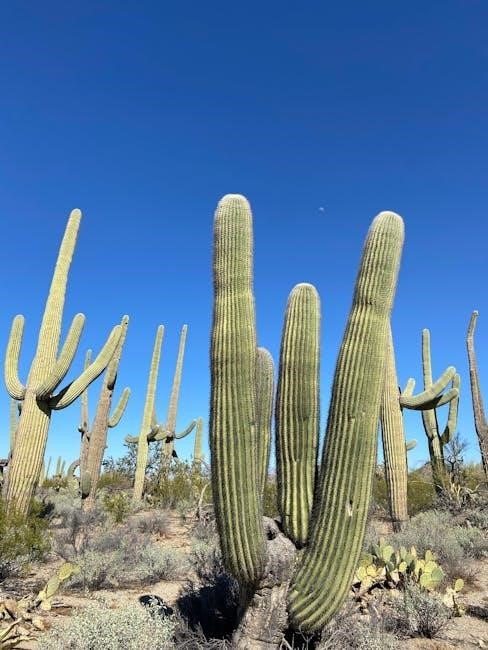
Maintaining Your Arizona Desert Landscape
Maintaining your Arizona desert landscape requires careful watering strategies and soil considerations. Adherence to local regulations protecting plants is also essential for responsible landscaping.
Watering Strategies for Established Plants
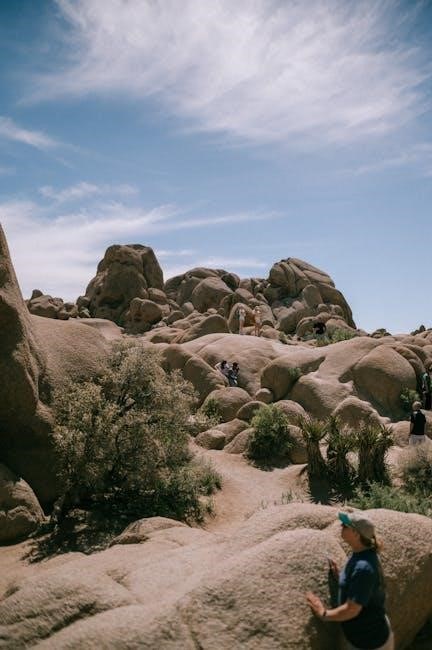
Once Arizona desert plants are established‚ typically after one year for shrubs and three years for trees‚ their watering needs change. Deep‚ infrequent watering is generally more effective than frequent‚ shallow watering. This encourages deep root growth‚ making plants more resilient to drought conditions. Observe your plants for signs of stress‚ such as wilting or discoloration‚ which can indicate underwatering or overwatering.
Consider the specific water requirements of each plant species in your landscape. Native desert plants are generally more drought-tolerant than non-native species. Adjust your watering schedule based on seasonal changes‚ with less water needed during cooler months. Use a rain gauge to monitor rainfall and adjust irrigation accordingly. Applying mulch around plants helps to retain moisture in the soil and reduce evaporation. Regularly check your irrigation system for leaks or malfunctions to ensure efficient water use. Remember that overwatering can be as harmful as underwatering‚ leading to root rot and other problems. Always prioritize water conservation to maintain a healthy and sustainable desert landscape.
Soil Considerations for Desert Plants
Arizona’s native soils are often alkaline and nutrient-poor‚ presenting a challenge for cultivating desert plants. Understanding your soil type is crucial for successful landscaping. Conducting a soil test can help determine its pH‚ nutrient levels‚ and drainage properties. Amending the soil with organic matter‚ such as compost or aged manure‚ can improve its structure and fertility. This helps to retain moisture and provide essential nutrients for plant growth.
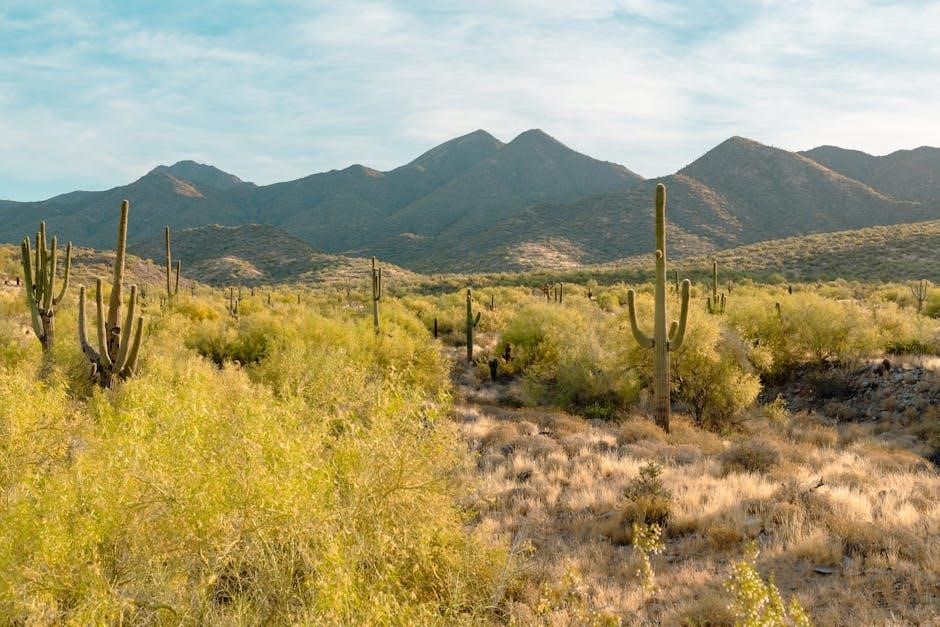
Good drainage is essential for desert plants‚ as they are susceptible to root rot in waterlogged soils. If your soil is heavy clay‚ consider adding sand or gravel to improve drainage. Avoid using excessive amounts of fertilizer‚ as this can harm desert plants that are adapted to low-nutrient conditions. Instead‚ focus on providing a balanced‚ slow-release fertilizer specifically formulated for desert plants. Mulching around plants can also help to regulate soil temperature and prevent weed growth. Remember that healthy soil is the foundation for a thriving desert landscape‚ so take the time to prepare and maintain it properly. The soil should mimic natural desert conditions.
Protecting Plants by law in many jurisdictions

Many native desert plants are protected by law in various jurisdictions‚ including Arizona. These protections aim to preserve the natural desert landscape and prevent over-collection of vulnerable species. Before removing or transplanting any native plants‚ it’s crucial to check local regulations and obtain any necessary permits. Some plants may be completely protected‚ meaning it’s illegal to remove them from their natural habitat. Others may have restrictions on harvesting seeds or propagating them for commercial purposes.
Arizona‚ in particular‚ has laws in place to protect certain native plants from being damaged or destroyed. These laws are enforced to maintain the ecological balance of the desert environment. Ignoring these regulations can result in fines or other penalties. Responsible landscaping practices involve using sustainably sourced plants and avoiding the use of invasive species that could harm native ecosystems. Always be mindful of the impact your landscaping choices have on the environment and ensure you are complying with all applicable laws. This ensures preservation of the desert’s natural beauty for future generations. Consider consulting with local experts for guidance.
